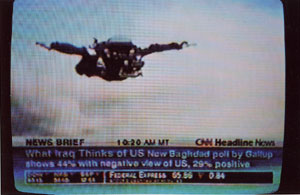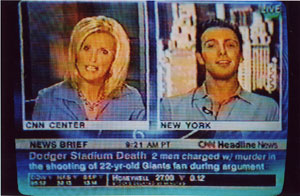» home » portfolio » adventure
World record HALO Jump
A GREAT many things go through your mind when you feel you are about to die a brutal, needless death in the next few minutes. We sit tightly, shoulder to shoulder in a –10 degree chill, fast getting colder as the plane’s rattling drone makes speech impossible. Despite the savage cold I am wreathed in sweat and hyperventilating with such force that I suck oxygen though the sweaty, flesh-like rubber of my mask in rapid, asthmatic thumps.
I’m supposed to jump out of this plane when we reach 30,000ft. That’s airline cruising altitude, seventy feet higher than Mount Everest, and six miles above the earth’s unforgiving crust. Without a flight hostess, cocktail peanuts and a pressurized cabin, it’s a place you have about thirty seconds of useful consciousness before you black out from lack of oxygen and risk severe brain damage from hypoxia.
Open your parachute at this height and it will explode, at which time you will plummet to earth in a blizzard of confetti -- the air being so thin that you fall at twice the speed of terminal velocity, too much force for a parachute to take. And even if your parachute doesn’t explode your neck or back will with the shock of it opening. This is the earth’s troposphere and it is a very, very bad altitude.
And here I am readying myself with a slow, sickly feeling to parachute from this height. This I am supposed to do whilst never having parachuted in my life, or even for that matter, been off so much as a high diving board.
I can feel the expressionless eyes of the other men, hard men who have killed for their country, searching for weaknesses in my demeanor. I can’t divine their facial expressions under their masks but I hope they can’t tell by looking in my eyes that I am fighting the instinct to save my own skin. Paranoid, I stare at the floor as I think: ‘Its not too late to back out.’ I don’t care about money or glory or breaking a parachuting world record. I just want to live.
I am to be attached by four clips to an experienced skydiver in a harness called a tandem and, if we live, we will enter the Guinness Book of Records as the highest tandem skydive in the world. Rumors around here are that the last person who tried a high altitude tandem skydive went from 27,000ft -- only to black out in freefall due to lack of oxygen. His passenger had to plummet to earth strapped to an unconscious body, which fortunately revived at 15000 ft – normal skydiving altitude. It gave him enough time, mercifully, to pull his parachute.
None of this is that new to the military. They have been using HALO (High Altitude Low Opening) jumps to furtively insert Special Forces soldiers deep behind enemy lines for years. At 25 to 30 000ft the plane is invisible, if anything just a dull murmur above the clouds. To radar it looks like a commercial flight, if identified at all, and troops can fall from the skies with silent, lethal anonymity.
Before JDAMs, cruise missiles and laser guided smart bombs there were men with suitcases. In the 1950’s, at the height of the cold war and the nuclear age, the most precise way to deliver a nuclear device behind enemy lines was by paratrooper. Back then HALO was so secret that both the Army and the Marine Corps were working on it without the other knowing. HALO was first used in the Vietnam war and has been a staple of Special Forces deployment ever since. Today the Military Freefall school in Yuma, Arizona is the most sought after course in the military. Only 570 elite special forces troops, drawn from all four services, graduate each year.
At West Tennessee Skydiving Centre, just outside Memphis, there are tattooed Marines wanting to HALO as well as tie-dyed T-shirt-wearing thrill junkies looking for the ultimate sky diving experience. Since 2001 a small company called Superior Jumps (based in New Orleans and run by an ex Special Forces major) has been offering HALO jumps to civilian skydivers. Its founder, 47-year-old Kevin Holbrook, was with Ist Special Forces Group in a distinguished career leading men into combat in El Salvador, Grenada and the Gulf War before he was discharged in 1991.
An intelligent, warmly convivial man with a large frame, he has thrived outside of the military as an entrepreneur. With a degree in psychology obtained while in the military, he opened treatment a center for persons with developmental disabilities on his discharge and later a restaurant too, both of which have flourished. But he grew bored of the European sports cars, restaurants and money his business acumen has given him. He even grew bored with the sport skydiving he did at weekends for kicks. So in 1998 bought an old HALO oxygen console and began accumulating equipment, for ‘nostalgia’ and a nod to his days as a HALO jumpmaster. “My intent was just to take a bunch of friends, break a few records and leave my mark on the sport,” he told me in his gentle, vowel-flattened twang. With the HALO equipment in hand, he has smashed high altitude civilian skydiving records in Mississippi and prominently in Tennessee where a 30 850 skydive broke the state record. But all this has just been a warm up to breaking world records.
With me, a novice jumper, he intends to break the world’s highest tandem jump record. “This is certainly pushing the envelope,” he had told me. “It is a frightening thing. The only thing I can compare the feeling to is that it’s like going into combat with us.”
Kevin leads his men like a tight-knit unit. His right hand man is Vick Myrick, a Marine Corps sniper, naturally wary of newcomers at first and then eager to help. Sitting across from me in the twin-prop Super KingAir, there’s Nagel Ledet,45, a former Army Ranger now a sheriff’s deputy in Louisiana with a round, rubbery face and a boisterous sense of humor which is about as subtle as an M-16. “I’ll tell you something man,” he had said clapping me on the back before we left. “It ain’t the extra 20,000-ft you’re adding to a normal skydive that will kill ya, it’s the ground. Bang! You can hit that at 100 feet and it’ll still kill ya.” He laughed. “See, nothing to worry about.” And then there’s my most important ally: US Coast Guard Senior Chief Gunner’s Mate Ben Crowell, 42, a laconic, punctilious man with a thinly disguised mean streak who has swam under the polar ice caps and seen action on US Coastguard covert operations. I will be strapped to him for the jump. As the plane continues its ascent, I give up trying to distract myself by approximating how many men they have killed between them when I realize that the next person they are likely to kill is me.
On average, a parachutist will have a malfunction every 333 jumps. I ask Ben about the last time he had one, and how many jumps he had made since, in a bid to work out our chances of surviving. Out of around 2500 jumps he has had seven malfunctions -- the last of them only two months ago. He’s due for another. “Look, whatever happens to you will happen to me a split second later,” he said dismissively, as we begin to pre-breathe. Because the descent is so rapid we must purge our bodies of nitrogen, which would induce the bends, so we don masks and hook up to the oxygen half an hour before take-off.
Twenty minutes later, at 27,000ft, the sky is an electric cirrus blue, and Ben orders me to my knees. He holds up two fingers, meaning two minutes to jump. The air hose to the oxygen console on the plane is replaced with a hose to four small oxygen bottles attached to my waist, which will supply both mine and Ben’s oxygen for the way down. Ben kneels behind me and I feel him attaching his harness to mine, tightly.
The door is slid upward and a roar of propeller wash and icy, –38 degree air hits me in the face. Ben and I move to the doorframe, cumbersomely waddling on our knees, and it dawns on me that I will be the first out. I accept my fate, head bowed, and kneeling like a man awaiting a shot to the back of the head. Ben had told me, “Whatever you do don’t try to hold on to the door if you change your mind, because I’ll break your arms if you do. No, no, no sounds a lot like go, go, go to me.”
We rock forward once, and as I clench my teeth and look down the world seems to have vanished. A field far below has shrunk to the size of my thumbnail. Remembering I was told not to look down, I look up to see the moon -- which makes me feel infinitely worse. Then the crashing realization of just how high we are hits me before my reverie is interrupted: “Exit! Exit! Exit!.
I expected to go on three but actually we go on two - tumbling out of the door on the second rock in a slow, lazy outward arc. For a split second you feel suspended and then acceleration begins, ferociously. We hit 250 mph and it feels not as if I am falling, but rather as if I am being furiously ripped out of the sky. I feel my brain shutting down sensory functions as it frantically tries to process just what the hell is going on. It’s like connecting a broadband cable to a Radio Shack calculator.
Hurtling downwards, the first thing I notice is that the world is a weird, Martian red color at this height. The second is that I am not wearing a parachute. In the panic I finally deduce the red color is due to the lenses of my goggles. Then I berate myself for allowing myself to be thrown out of a plane without a parachute, entrusting myself to someone I’ve only met once. I have an outbreak of paranoia. We are both entrusting our lives to a tatty, black nylon backpack whose width is no bigger than a fist. The weight of the oxygen bottles drags Ben and I to the left in the harness. He has to keep pulling me right to stay straight. We were also meant to have radio contact for the freefall but all I hear is static in my ears - the radio has gone dead.
Strangely, the ground never seems to get any nearer. It’s like the join between the past and future has somehow become elasticized and is being stretched to an eternity. Ben keeps jabbing the altimeter in my face; the hands turn like a spastic clock. Above I see Nagel and the others swooping over the earth, ready to swoop in and help if there are problems, and as I look down I see the curve of the planet. I struggle to rationalize. Then I remember the nightmare I had as a child of falling and falling, waiting for impact and never hitting the ground. It feels like that.
Then there’s a moment of arrest when we hit 15,000ft. Here the atmosphere is thicker and warmer again and we slow to terminal velocity -- 126mph – normal skydiving speed.
And then, after two minutes and fifteen seconds of freefall, comes the moment I have been dreading. At 6500 feet, with no warning, my legs swing down and I am jerked powerfully upwards in a movement I imagine being hung from a gallows must feel like. A pink piece of fabric, part of 380 sq ft of material, is just visible directly upwards. The canopy has opened without fault.
Dangling above the earth, I release my mask, tremulously, and take huge gasps of fresh air. As we glide down in gentle tacking turns, I am so giddy on exhilaration that my concept of height is skewed. Even though we are roughly the height of the Empire State Building, I start to undo my harness, feeling that I can gingerly place a foot on the ground. I stop myself.
After eight minutes, Ben pulls both toggles to ‘flare’ the chute and we alight gently. The others were down before us. Nagel comes over to give me a bear hug, Kevin beams broadly. “You’re one of us now brother,” they say shaking my hand. The bonding and camaraderie got me through, but to think of others going into combat after this induces awe and respect. At first I was just pleased to be alive, but everyone had told me that not only would my perception of the world would change but I may become addicted to it, like a junkie with his first hit. In the weeks afterwards it was like I had been made aware of another dimension. New York didn’t seem the soaring metropolis it was when I left. And like one who has plucked up courage to move his hand through a candle flame for the first time and didn’t get burnt, and then with the surprise of no pain, keeps doing it over, I started to think of skydiving again.
But right there when I landed I felt like a child who’s been abused. I couldn’t remember details about the jump until hours later. My brain had literally shut it all out to protect my consciousness. Only on the plane on the way home did the enormity of what I had done sink in. “This is your Captain speaking. We will be flying at an altitude of 29 000 feet. Enjoy your flight.” I smiled.
HALO jumps can be made from the West Tennessee Skydiving Center. Experienced skydivers can HALO for around $325, tandems are priced by special arrangement.
Contact Kevin Holbrook at www.halojumper.com
A thank you to Relative Workshop for providing the tandem harness. www.realtiveworkshop.com Tel: +1 386 736 7589.








